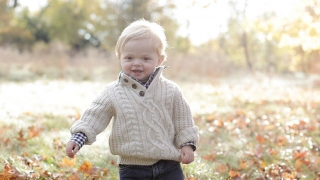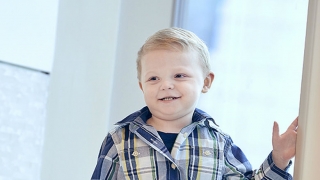Biliary Atresia and Liver Transplant: Parker's Story
Published on
Published on
Parker is an energetic, fun-loving 2-year-old. When he was a year old, a liver transplant saved his life. The live donor was his mother’s best friend.
 Parker showed no signs of health problems as a newborn. Then, when he was 2 months old, his parents, Jessica and Stephen, noticed that his eyes were yellow. They called the pediatrician, who asked them to bring Parker in immediately. He took blood samples, and the lab results showed elevated levels of bilirubin, a sign of liver problems. He instructed the parents to take Parker to the local emergency room for additional tests. There, tests confirmed the earlier results, and an ultrasound found that Parker was missing his gallbladder.
Parker showed no signs of health problems as a newborn. Then, when he was 2 months old, his parents, Jessica and Stephen, noticed that his eyes were yellow. They called the pediatrician, who asked them to bring Parker in immediately. He took blood samples, and the lab results showed elevated levels of bilirubin, a sign of liver problems. He instructed the parents to take Parker to the local emergency room for additional tests. There, tests confirmed the earlier results, and an ultrasound found that Parker was missing his gallbladder.
The doctor believed that Parker had biliary atresia, a serious liver disorder in which the bile ducts become inflamed, which then blocks the flow of bile from the liver to the intestines. The bile blockage causes liver damage and interferes with digestion and other metabolic processes. Parker’s doctor told Jessica and Stephen that their son would need care at a hospital with expertise in treating childhood liver disease.
The family lives in central New Jersey, halfway between New York and Philadelphia. A quick web search showed that Children’s Hospital of Philadelphia (CHOP) had a dedicated Biliary Atresia Clinic Care Program with years of experience in treating the condition, and one of the largest pediatric liver transplant centers in the country.
Two days later, Parker arrived at CHOP. Jessica and Stephen met with Henry Lin, MD, a pediatric gastroenterologist at CHOP with special expertise in treating children with liver disorders, and other members of the GI team. Dr. Lin explained the need for additional tests and for speed in identifying and addressing Parker’s problem.
As the test results came back, Dr. Lin recommended an operation known as the Kasai procedure, which creates a new pathway to drain bile from the liver into the intestine. In some cases, the correction fixes the bile flow problem, but the more common outcome is to restore enough flow to delay the need for a liver transplant.
The Kasai procedure was performed on Parker that week by pediatric surgeon Alan Flake, MD. Unfortunately, the procedure did not do much to improve Parker’s health. The jaundice remained, and he developed itchy skin. He stopped gaining weight, and slowly dropped to the very bottom of the growth chart. Bouts of fever, liver infection (cholangitis) and GI bleeding — all complications of biliary atresia — led to frequent hospitalizations.
At the end of October, Dr. Lin started discussing plans for a liver transplant with the family. Parker was put on the transplant list in December.
The Liver Transplant Program at CHOP performs different types of transplants — whole or segmental graft organs from deceased donors, and live-donor transplants. Parker was a candidate for all. If a live donor could be found with the right match to Parker, he might be able to bypass the uncertain wait for a deceased donor.
Unlike other organs, such as the heart, in which the entire organ must be transplanted and size is a critical factor in childhood transplants, a portion of the liver can be transplanted. A healthy adult can be a liver donor for a child, even a baby like Parker. When this is done, the adult’s liver can grow back to its former size.
Neither parent was a candidate as a donor, as their blood types were incompatible with Parker’s. In Jessica’s regular conversations with her good friend, Lauren, she had described their search for a living donor. Jessica and Lauren had been friends since kindergarten. Though they lived in different states, they got together regularly, and both had children who enjoyed playing together.
Although she considered being tested, Lauren was nonetheless wary, at first, at the idea of being a liver donor. “I had a lot to lose,” Lauren remembers. “With four young children, my health was important. Also, the thought of major surgery was scary to me.” Still, she took the first steps of getting tested and learning about the process, traveling from her home in Rhode Island to Philadelphia. She was found to be a perfect match for Parker.
Over the next few months, Lauren overcame her hesitation and agreed to be Parker’s donor. A key emotional factor was her experience with her two youngest children, who were born prematurely and spent several months in neonatal intensive care. “Our friends would have done anything to help us at that time,” Lauren recalls.
“I just had this feeling that this was my chance to give back by helping Parker.”
On July 12, when Parker was just over a year old, he and Lauren underwent their separate procedures. Lauren had a portion of her liver removed in an operation at the Hospital of the University of Pennsylvania (HUP). Across the street at CHOP, Parker had the operation to replace his failing liver with the healthy portion of Lauren’s. His transplant was performed by Kim Olthoff, MD, Director of the Surgical Liver Transplant Program at CHOP.
 After the procedure, Lauren recovered in her hospital and Parker in his.
After the procedure, Lauren recovered in her hospital and Parker in his.
Lauren’s recovery went well. She was discharged from the hospital within a few days and was able to return to work six weeks later. “I was still sore and tired at that point,” she says, “But I continued to feel better. By the one-year anniversary, it didn’t feel like anything had even happened.”
Parker’s recovery was gradual, too. By the fifth day after his transplant, he was alert, looking around and wanting to play. “By day nine, he was standing up and trying to grab the medical equipment on the wall,” Jessica remembers. She also recalls the change in his coloring. The yellow tint drained from his eyes first, then from his skin. He looked healthy again.
Four weeks after the transplant, Parker was walking for the first time. He had been too weak before to try. He was also sleeping through the night, something he had never done, and that refreshed him and raised his spirits.
“The amount of energy he had was amazing. It was like having a whole new child.”
To celebrate the one-year anniversary of the transplant, Jessica and Lauren took their families for a week-long vacation together at the beach. “There was no stopping Parker,” Jessica says. “He was swimming in the pool, running on the boardwalk, playing at the beach.”
By this time, Lauren was feeling completely recovered, too. She had the energy to fully enjoy the time with all of the kids, and it was a special treat for her to see the healthy little boy Parker had become. She’d given the gift that saved his life and enabled this energetic, joyful personality to emerge.
Today, Jessica describes Parker as “the healthiest, happiest 2-year-old you’d ever meet. He has the best belly laugh. He lights up the room when he laughs.” He loves being outside, swinging at the playground, running, swimming, riding his tricycle and crawling through bushes to look at insects.
Parker comes back to CHOP for lab tests every three months and for the liver clinic every six months. Parker looks forward to his visits, even his blood draws. He’s become good friends with the technician who does those, and cries if another child goes in before him.
“Everyone is amazing at CHOP. I can contact the nurse practitioners at any time, 24 hours a day, seven days a week, and they always get right back to me. They coordinate Parker’s care with his local doctors, even his dentist. I feel like we are in such good hands with CHOP.”